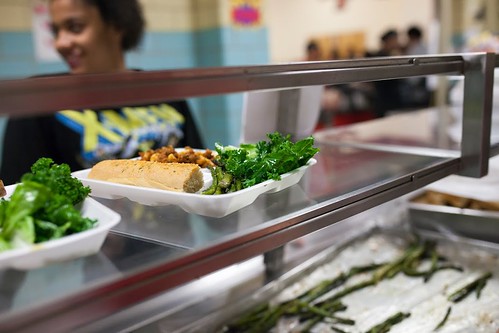
The things that make our country so great and special can be found in the diversity of the people, their ideas, and their culture. One of the ways culture is expressed is through the foods we eat. Our nation’s school meals should be no exception. More than 30 million children receive at least one nutritious meal every school day through the USDA’s National School Lunch and School Breakfast programs.
My commitment is to make sure these children have access to healthy, nutritious meals while they learn. The Healthy, Hunger-Free Kids Act (HHFKA) has helped raise the nutritional value of the foods our children eat with meal standards that promote health during the years most critical for growing kids. The meal standards have been developed to not only offer healthy meal options, but to allow schools the flexibility to prepare meals that are familiar to kids from culturally diverse backgrounds.
Recently, I learned of several examples of this while participating in one of the Team Up for School Nutrition Success workshops that USDA provides to assist school food authorities. The goal of this training is to help schools find simple ways to meet the updated meal standards while increasing the number of children enjoying healthy and flavorful school meals. It’s no secret that children and adolescents can be finicky eaters, but there are creative ways school nutrition professionals can prepare meals to be tastier and more appealing for this tough audience.
For instance, I learned that in Puerto Rico it is common for children to eat arroz con habichuelas y carne de cerdo (rice and beans with pork). Schools are finding ways to prepare this same meal in a healthy way that satisfies the palates of children who are used to eating it at home.

In the same way, school children in the Southwest region of the United States enjoy burritos and refried beans that are similar to what they might have at home. In West Virginia, schools have found ways to offer healthy versions of Southern-style cooking like sausage gravy and a long-time favorite in the state—the pepperoni roll.
Our goal at USDA is to ensure children have access to nutritious food that nourishes their growing bodies—all while embracing diverse cultural customs and cuisines. I’m confident that through cultural inclusion and nutritious choices, schools across America will pave the way for a healthier next generation.

Find new ways to make your favorite cultural dishes healthier and don’t be afraid to get creative. Check out this video to learn how to make delicious vegetable fried rice!
For more culturally flavored dishes check out these MyPlate-inspired recipes on ChooseMyPlate.gov
